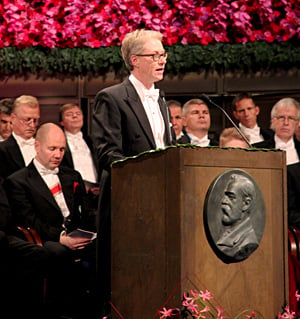Award ceremony speech
English
Presentation Speech by Professor Christer Höög, Member of the Nobel Assembly at Karolinska Institutet, 10 December 2010
 |
| Professor Christer Höög delivering the Presentation Speech for the 2010 Nobel Prize in Physiology or Medicine at the Stockholm Concert Hall. Copyright © The Nobel Foundation 2010 Photo: AnnaLisa B. Andersson |
Your Majesties, Your Royal Highnesses, Ladies and Gentlemen,
The 2010 Nobel Prize in Physiology or Medicine rewards one of the great medical advances of our age, in vitro fertilisation − also called test tube fertilisation. Like a miracle, this method has enabled many involuntarily childless couples to have babies.
Behind this scientific breakthrough was British researcher Robert Edwards. Starting with his basic scientific research on reproductive biology, he saw the potential for treating infertility, a medical condition that afflicts more than 10 per cent of humanity.
Infertility is often caused by the failure of sperm and eggs to meet in the natural way. In the early 1960s, Edwards decided to try to develop a method for fertilising human eggs outside the body and only then returning them to the woman. This visionary research project ran into resistance from the establishment, since it raised questions about the beginnings of life and the natural limitations of humans. At an early stage, Edwards thus initiated an ethical debate about in vitro fertilisation − a debate that helped this method to become generally accepted over time.
Many scientific issues needed to be resolved in order for in vitro fertilisation to become a reality − issues that Edwards addressed systematically. During the 1960s he clarified the maturation process of human eggs outside the body and in what way various hormones affect this process. In 1969, Edwards and his colleagues showed that human eggs could be fertilised outside the body, a revolutionary discovery.
Working with gynaecological experts, Edwards then began the research work that was required in order to transform basic scientific insights into clinical treatment. They succeeded in showing that a human egg fertilised outside the body could generate an early embryo. But the most important question remained: Could an egg fertilised outside the body lead to a pregnancy and the birth of a baby?
After many years of experiments, this question was finally answered. On July 25, 1978, Louise Joy Brown was born − the first baby conceived through in vitro fertilisation. Today in vitro fertilisation is an established method for treating infertility, and with the help of this method more than four million babies have been born. These babies are as healthy as those born in the natural way, and many of them have now reached adulthood and have had babies of their own.
By charting a new territory in medicine, Robert Edwards has given new hope to millions of people who were involuntarily childless. With his scientific vision and his personal courage, he has showed all of us an example of how a medical therapy, though highly controversial at first, can become established over time.
Dear Robert Edwards,
The development of human in vitro fertilisation has made it possible to treat infertility, a medical condition that afflicts a large proportion of humanity. Your pioneering work therefore represents a monumental achievement that truly can be said to confer the greatest benefit to mankind. The result of your work has touched us all, giving millions of infertile couples a precious gift, a child.
On behalf of the Nobel Assembly at Karolinska Institutet, it is my great privilege to convey to you our warmest congratulations and our deepest admiration.
In the absence of this year’s Nobel Laureate in Physiology or Medicine, I ask Professor Edwards’ wife and long-term scientific companion, Dr Ruth Fowler Edwards, to come forward and receive his Prize from the hands of His Majesty the King.
Nobel Prizes and laureates
Six prizes were awarded for achievements that have conferred the greatest benefit to humankind. The 14 laureates' work and discoveries range from quantum tunnelling to promoting democratic rights.
See them all presented here.
